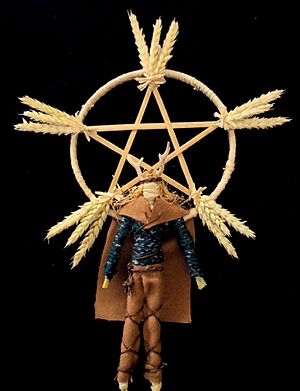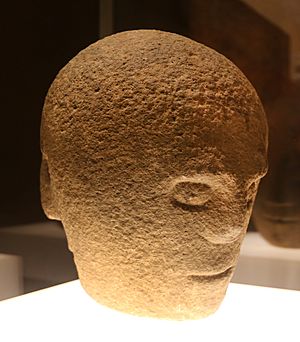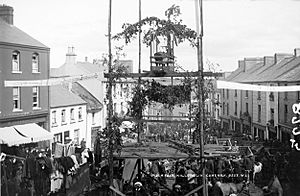Lughnasadh facts for kids
Quick facts for kids Lughnasadh |
|
|---|---|
| Also called | Lúnasa (Modern Irish) Lùnastal (Scottish Gaelic) Luanistyn (Manx Gaelic) |
| Observed by | Historically: Gaels Today: Irish people, Scottish people, Manx people, Celtic neopagans, Wiccans |
| Type | Cultural, Pagan (Celtic polytheism, Celtic neopaganism) |
| Significance | beginning of the harvest season |
| Celebrations | Offering of First Fruits, feasting, handfasting, fairs, athletic contests |
| Date | 1 August |
| Related to | Calan Awst, Lammas |
Lughnasadh, also called Lughnasa or Lúnasa, is an old Gaelic festival. It marks the start of the harvest season. In Ireland, it is even an official holiday! People in Ireland, Scotland, and the Isle of Man have celebrated it for a very long time.
This festival usually happens on August 1st. This date is about halfway between the longest day of summer (summer solstice) and the start of autumn (autumn equinox). In more recent times, some celebrations moved to the Sunday closest to August 1st. Lughnasadh is one of four main Gaelic seasonal festivals. The others are Samhain, Imbolc, and Beltane. It is similar to the Welsh festival Gŵyl Awst and the English festival Lammas.
Lughnasadh is mentioned in very old Irish stories. It has roots in ancient pagan beliefs. The festival is named after the god Lugh. In the Middle Ages, people held big gatherings for Lughnasadh. These events included special ceremonies, sports contests, and horse races. There were also big feasts, matchmaking for young people, and trading.
Experts believe that these old religious events included offering the first crops of the season. People would also have a feast with new food. Sometimes, a bull was sacrificed, and there was a special dance. The festival continued to be widely celebrated until the 1900s. It was known by different names like Garland Sunday or Mountain Sunday.
Today, some traditions still exist. Climbing hills and mountains at Lughnasadh has become a Christian pilgrimage in some areas. The most famous one is Reek Sunday. This is a pilgrimage to the top of Croagh Patrick in Ireland. Other fairs, like the Puck Fair, are also thought to be old Lughnasadh celebrations. Since the late 1900s, some modern pagans, like Celtic neopagans, celebrate Lughnasadh as a religious holiday. Some places have also brought back parts of the festival as cultural events.

What's in a Name?
The name Lughnasadh comes from Old Irish. It was originally Lugnasad. This name combines Lug (the god Lugh) and násad (meaning an assembly or gathering). So, it means "Lugh's assembly." Some people think it might also come from the word nás, meaning "death."
Different Names for Lughnasadh
In modern Irish, the festival is called Lúnasa. This is also the name for the month of August. So, "Mí Lúnasa" means "Month of August." In Scottish Gaelic, it's called Lùnastal. In Manx Gaelic, it's Luanistyn. The day itself can be called Laa Luanistyn or Laa Luanys.
In Welsh, the day is known as Calan Awst. This comes from a Latin term meaning "the Calends of August." In Breton, it was called Gouel Eost, which means "Feast of August."
Stories and Beliefs of Lughnasadh
Irish myths say that the god Lugh started Lughnasadh. He created it as a special feast and sports competition. This was to remember the death of an earth goddess. Old Irish stories about Lughnasadh often feature a woman who is taken away. She then dies from sadness or exhaustion. Some people see similarities to the Greek story of Persephone.
One story says Lugh started the festival at Tailtin. This was to honor his foster-mother, Tailtiu. She was said to have died from working too hard. She cleared the plains of Ireland for farming. Tailtiu might have been an earth goddess. She could have represented the plants that died to feed people. Another story says Lugh started the festival to remember his two wives, Nás and Bói. Some believe the festival was a way to mourn the end of summer.
The Harvest Battle
An expert named Máire MacNeill studied Lughnasadh traditions. She found that a main idea was a fight for the harvest. This fight was between two gods. One god, often called Crom Dubh, protected the grain. The other god, Lugh, had to take it for humans. Sometimes, this fight was over a woman named Eithne, who represented the grain. Lugh also fought and defeated a figure that represented plant diseases.
MacNeill believed these ideas came from older Irish myths. For example, Lugh defeating Balor might show him overcoming disease or very hot, dry weather. In later stories, Saint Patrick often replaced Lugh. Crom Dubh became a pagan chief who fought Patrick but was defeated and converted. Crom Dubh might be linked to other gods like Crom Cruach or the Dagda. He might be like an underworld god who takes the grain goddess. But he is forced to let her return before harvest.
Old Lughnasadh Customs
In the Middle Ages, a big event called the Óenach Tailten was held at Tailtin. This happened every Lughnasadh. Kings would attend, and a truce was called. It was like the Ancient Olympic Games. It included sports, horse racing, music, and storytelling. People also traded, made laws, settled arguments, and even arranged marriages.
At Tailtin, young couples could enter "trial marriages." They would join hands through a hole in a wooden door. This marriage lasted a year and a day. After that, they could make it permanent or end it without problems. The Óenach Tailten happened less often after the 9th century and eventually stopped. It was brought back for a short time in the 1900s. Another Lughnasadh gathering was the Óenach Carmain. This included markets for food, animals, and foreign traders.
What People Did
Many Lughnasadh customs were recorded from the 1700s to the mid-1900s. Máire MacNeill's book, The Festival of Lughnasa, studied these customs. She found that the ancient festival around August 1st involved these things:
- Cutting the first corn and offering it to a god. This was done by taking it to a high place and burying it.
- Eating a meal with the new food and bilberries. Everyone had to eat some.
- Sacrificing a sacred bull and feasting on its meat.
- A special dance that might have shown a fight for a goddess.
- A ritual fight.
- A three-day celebration led by a person representing Lugh.

Many of these old customs continued into modern times. But they became more Christian or lost their pagan meaning. Lughnasadh was a tough time for farmers. The old crops were gone, and the new ones were not ready. Many important mountains and hills in Ireland were climbed at Lughnasadh. Some of these climbs became Christian pilgrimages. The most famous is Reek Sunday at Croagh Patrick. Other hill gatherings were just for fun, especially for young people.
In Ireland, people gathered bilberries. They ate, drank, danced, played folk music, and played games. There were also sports like weight-throwing, hurling, and horse racing. At some gatherings, people wore flowers while climbing a hill. Then they buried the flowers at the top to show summer was ending. In other places, the first bundle of harvested crops was buried. There were also fights between groups of young men using sticks.
Special Meals and Offerings
Bull sacrifices at Lughnasadh were still recorded in the 1700s in Ireland. They were offered to Crom Dubh. In Scotland, they were offered to Saint Máel Ruba. Special meals were made with the first foods of the harvest. In the Scottish Highlands, people made a special cake called the lunastain. This might have been an offering to the gods.
Another custom was visiting holy wells. People would pray for health while walking around the well. They would then leave offerings like coins or pieces of cloth. Sometimes, bonfires were lit at outdoor gatherings in Ireland. But they were not a main part of the celebrations.
When Lughnasadh Was Celebrated
Traditionally, Lughnasadh was always on August 1st. But in recent centuries, many gatherings moved to the nearest Sunday. This was either the last Sunday in July or the first Sunday in August. This probably happened because harvest time was busy. Farmers could not take off workdays. Sundays were already days of rest, so it made sense to celebrate then. The change to the Gregorian calendar might also have affected the date.
Lughnasadh was a time of unpredictable weather in Ireland. Heavy rains, called "Lammas floods," often happened in early August. These rains could destroy crops. There are many old sayings about the weather during Lughnasadh. They show how important the weather was for the harvest: "For Lammas floods, with crops oft havoc play, And e'en one swept the rustic bridge away." "August needs the dew as much as men need bread. After Lammas corn ripens as much by night as by day."
Lughnasadh Today
Some mountain pilgrimages in Ireland still happen today. The most popular is Reek Sunday at Croagh Patrick. It attracts thousands of people every year.
The Puck Fair takes place every year in early August. It is in Killorglin, County Kerry, Ireland. This fair has been around since at least the 1500s. Many believe it is a survival of a Lughnasadh festival. At the start of the three-day fair, a wild goat is brought into town. It is crowned "king." A local girl is crowned "queen." The fair has traditional music, dancing, a parade, and workshops for arts and crafts. There is also a horse and cattle fair and a market. Many tourists visit the Puck Fair each year.
Modern Festivals
In recent years, other towns in Ireland have started their own Lughnasa Festivals and Fairs. Like the Puck Fair, these often have traditional music, dancing, arts and crafts, storytelling, and markets. Festivals have been held in places like Gweedore, Sligo, and Brandon.
Craggaunowen, an outdoor museum in County Clare, has a yearly Lughnasa Festival. Here, people dressed in old costumes show what daily life was like in Gaelic Ireland. They show replica clothes, tools, weapons, and jewelry. A similar event happens every year at Carrickfergus Castle in County Antrim. In 2011, the TV channel RTÉ even broadcast a "Lughnasa Live" program from Craggaunowen.
Irish families living in other countries sometimes still have family reunions and parties in August. This is a survival of the Lughnasadh festivities. But because of modern work schedules, these events might move to other holidays. For example, some families in the United States might celebrate around the Fourth of July.
The festival is also mentioned in the 1990 play Dancing at Lughnasa by Brian Friel. This play was later made into a film in 1998.
Lughnasadh in Modern Paganism
Some modern Pagans celebrate Lughnasadh. This includes Celtic neopagans. Even though they share the name, these celebrations can be very different. Some try to copy the old festival as closely as possible. Others, like Wiccans, combine traditions from many festivals.
Neopagans usually celebrate Lughnasadh on August 1st in the Northern Hemisphere. In the Southern Hemisphere, it's on February 1st. They often start their celebrations the evening before. Some neopagans celebrate it at the exact middle point between the summer solstice and autumn equinox. Or they celebrate on the full moon closest to this point.
Celtic Reconstructionist Pagans
Celtic Reconstructionist pagans try to bring back ancient Celtic religion. Their practices are based on research and old stories. But they might change them a little for modern life. They try not to mix traditions from different cultures.
Celtic Reconstructionists who follow Gaelic traditions celebrate Lughnasadh when the "first fruits" are ready. Or they celebrate on the full moon closest to this time. In some parts of the United States, this is when blueberries or blackberries are harvested. For Celtic Reconstructionists, Lughnasadh is a time to thank the spirits and gods. They thank them for the start of the harvest season. They also offer prayers so that the crops still growing will not be harmed. Many honor the god Lugh at this time. Gentle rain on the festival day is seen as Lugh's presence and blessings. Many also honor the goddess Tailtiu. They might also try to stop the Cailleach from damaging the crops.
Wicca and Lughnasadh
Wiccans use the names "Lughnasadh" or "Lammas" for their first autumn harvest festival. It is one of eight yearly "Sabbats" in their Wheel of the Year. It comes after Midsummer and before Mabon. It is seen as one of the best times for handfasting (a type of spiritual marriage ceremony). The other good time is Beltane. Some Wiccans celebrate by baking a figure of the "corn god" in bread. Then they symbolically sacrifice and eat it.
See Also
- Aonach
- Celtic calendar
- Gaelic calendar
- Wheel of the Year
Images for kids
-
A modern Lughnasadh corn dolly representing the god Lugh
-
Pilgrims climbing Croagh Patrick on Reek Sunday. Climbing hills was a big part of the festival long ago. This pilgrimage is likely a continuation of that tradition.







